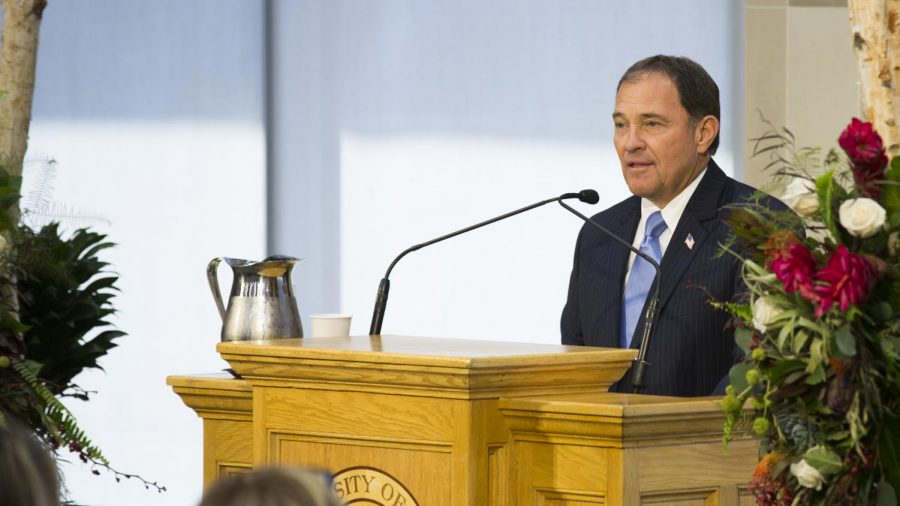Gov. Herbert Emphasizes Education in $20 Billion Budget Proposal
Governor Gary Herbert (R), at the dedication of the new S.J. Quinney School of Law building on Tuesday, Sept. 1, 2015 | Chronicle archives
January 22, 2020
On Jan. 8, in This is the Place Heritage Park, Governor Gary Herbert announced his $20 billion budget proposal for the 2021 fiscal year. Through this proposal, Herbert provided his economic recommendations for the Utah Legislature to hopefully put into effect. While he does not plan to run for reelection, Herbert’s budget proposal emphasizes his priorities for the state. The proposal allocates funds for transportation, social services and — above all — education.
Gov. Herbert has stated that his main budget priority is education. He proposed an allocation of $4.9 billion in state-directed investments to support K-12 public education. Herbert recommended that $10.2 million is set aside to ensure students have the opportunity to take computer science courses, which he believes will help better prepare students for a workforce increasingly powered by technology.
“Tech is booming all over the world, but especially in Utah. We want to make sure students have better access to up-to-date computer science, like coding,” said Anna Lehnardt, Communications Director for the Governor’s Office, in an email to the Chronicle.
To put his focus on education into practical effect, the governor hopes to make Utah the number one state for student achievement. “He believes that to plan for the state to succeed, we need to invest in and support our classrooms,” Lehnardt said. His recommended reforms for higher education — as stated in the Governor’s Budget Recommendation Book for the fiscal year 2021 — include freezing tuition until “affordability is adequately defined.” While Herbert does not have control over the regulation of education, he stated these goals as recommendations to the Board of Regents, whom he appoints.
“Tuitions and fees have increased really over the past couple of decades … It is good to think about assessing what this long term trend of tuition increase means for students and families,” said Jason L. Taylor, an Assistant Professor in the Department of Educational Leadership and Policy at the University of Utah. While a standard definition of affordability will be difficult to achieve, “it is good we are having a conversation about affordability,” Taylor said.
Another one of Herbert’s recommended reforms is to increase performance funding with specific goals for different institutions. These goals have not been detailed, as it is up to the local government to determine how they will interpret Herbert’s proposal and allocate their newly increased funds. However, some improvements that could be feasible within the bounds of the budget are “teacher support, building updates, safety upgrades [and] additional school counselors,” Lehnardt said.
“The research and literature on performance-based funding in higher education is somewhat mixed,” Taylor said. However, with ubiquitous equity gaps in terms of race, ethnicity, and income in college enrollment and completion, “it would be great for the University of Utah and other institutions to direct some resources towards closing gaps in college enrollment and college completion,” Taylor said.
While Gov. Herbert’s budget proposal is simply a list of suggestions for the Legislature to take into account, it is important to note that he placed emphasis on public and higher education, transportation and air quality as main areas where funds should be allocated. With the next General Session on the horizon, it is valuable to see the parts of Utah in which Herbert thinks need improvement.








